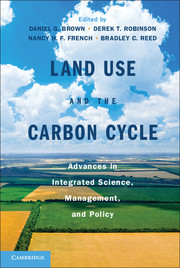Book contents
- Frontmatter
- Contents
- Chapter Authors and Affiliations
- Acknowledgments
- Acronyms
- Part I Introduction
- 1 Linking Land Use and the Carbon Cycle
- 2 An Introduction to Carbon Cycle Science
- 3 The Contribution of Land Use and Land-Use Change to the Carbon Cycle
- 4 An Economic Analysis of the Effect of Land Use on Terrestrial Carbon Storage
- Part II Measurement and Modeling
- Part III Integrated Science and Research Applications
- Part IV Land Policy, Management, and the Carbon Cycle
- Part V Synthesis and Future Directions
- Index
- Plate Section
- References
1 - Linking Land Use and the Carbon Cycle
Published online by Cambridge University Press: 05 February 2013
- Frontmatter
- Contents
- Chapter Authors and Affiliations
- Acknowledgments
- Acronyms
- Part I Introduction
- 1 Linking Land Use and the Carbon Cycle
- 2 An Introduction to Carbon Cycle Science
- 3 The Contribution of Land Use and Land-Use Change to the Carbon Cycle
- 4 An Economic Analysis of the Effect of Land Use on Terrestrial Carbon Storage
- Part II Measurement and Modeling
- Part III Integrated Science and Research Applications
- Part IV Land Policy, Management, and the Carbon Cycle
- Part V Synthesis and Future Directions
- Index
- Plate Section
- References
Summary
Introduction
The last few millennia have seen significant human intervention in the Earth system. For most of this time, the influence of humans on ecological processes, including the carbon (C) cycle, was limited to local-scale impacts through hunting and gathering and then through cultivation and animal husbandry. However, the start of the Industrial Revolution in the eighteenth century saw the collective action of humans begin to alter the C cycle at a global scale by changing the composition of the Earth's atmosphere (Hegerl et al. 2007). It is arguable that human impacts on global levels of atmospheric methane (CH4) and carbon dioxide (CO2) can be traced back thousands (not just hundreds) of years, largely driven by extensive land management through use of fire (Ruddiman 2003). Although the dominant anthropogenic influence on the global C cycle has resulted from the burning of fossil fuels, it has been estimated that land changes and land degradation have directly affected 39 to 50 percent of the land surface (Vitousek et al. 1997) and contributed to 30 percent of the total anthropogenic efflux of CO2 to the atmosphere (see Chapter 3). Humans have become integral actors in the C cycle – at both local and global scales – to such a degree that many now argue that no point on the surface of the Earth, or ecosystem, has escaped the effects of human activity (e.g., Ellis et al. 2010; Turner, Lambin, and Reenberg 2007).
Central to the theme of this book is the notion that as humans alter the surface of the land through land use and land management, they change the pools and fluxes of C across the Earth. Human actions affect the fundamental structure and function of the ecosystems, therefore altering the amount of C stored above- and belowground; the rate of transfer between the surface and the atmosphere; and how much ends up in the rivers, streams, lakes, and oceans. For example, when a forest is burned to clear the land, a large portion of the aboveground C is released to the atmosphere, some remains on site, and some is leached into the hydrological system. Not all of these fractions are known with a high degree of precision, but they vary by ecological context and frequency, duration, and intensity of fire.
- Type
- Chapter
- Information
- Land Use and the Carbon CycleAdvances in Integrated Science, Management, and Policy, pp. 3 - 23Publisher: Cambridge University PressPrint publication year: 2013
References
- 2
- Cited by



